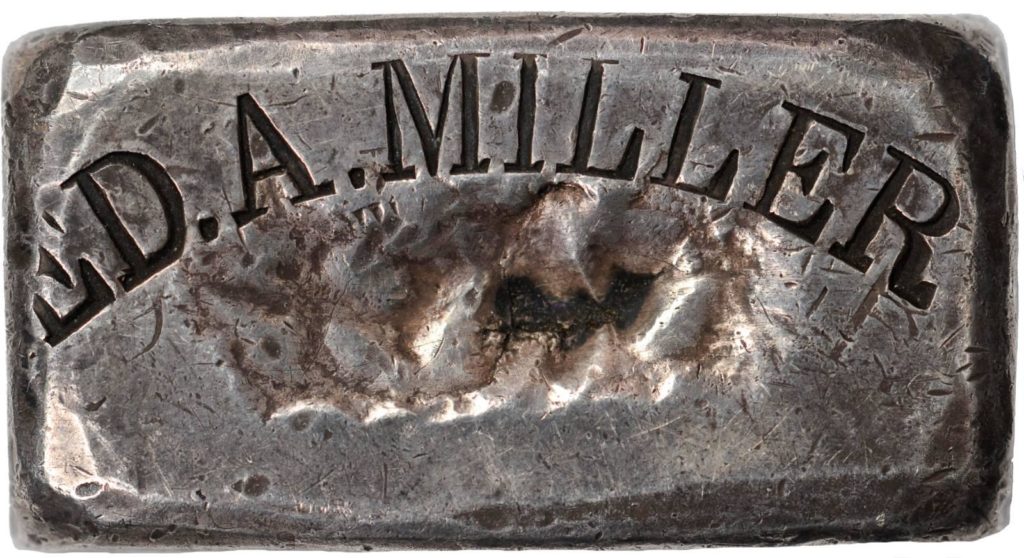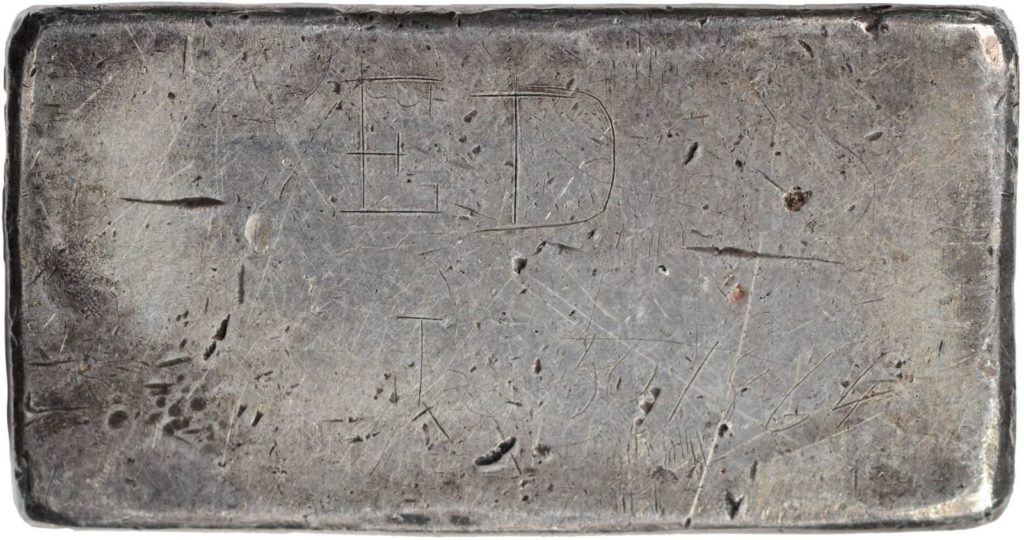Fred (ED) A. Miller, Assayer, Austin, Nevada. 1863-1865
A Silver Ingot Made for Circulating Currency
By Fred N. Holabird
Introduction
The Fred Miller silver ingot is one of the most important of the silver ingot discoveries of the past few years. He may have been the Pioneer assayer at Austin, Nevada and with partner David Lundbom, who had worked with Moffat, the S. F. Mint, Harvey Harris and others, and went on to build the longest running assay office in this important western Silver camp. An article in the Reese River Reveille suggests that this ingot may have been an experiment in circulating currency.
Fred Miller and Austin
Fred A. Miller was an assayer in the early boom days of the Reese River Rush at Austin, Nevada. He opened an assay office there in 1863 and quickly took control of all the assay business. During the early days, prospectors had found rich silver ores in the hills in the canyon immediately above their little stone village, and soon roamed the nearby hills and canyons for more ore. Most of the prospectors were gold miners from California. Several, who lacked the experience and knowledge of how to look for silver, hired Chilean miners to search for the silver veins. These men included some of the most important men of the region, David Buell, Washington Bartlett, Dr. Crowell, and A.C. Austin, the possible namesake of the town.
Austin had become the county seat of the new Lander County, formed about December 1862 with its temporary seat at Jacob’s Well along the Reese River, which was an outpost along the Overland Trail. Prospectors in the region first used Jacob’s Well as their camp, changing the name to Jacobsville after the silver discoveries started bringing people to the region. As more discoveries were made in the mountains, prospectors and speculators started a new camp 5 miles from Jacobsville called Clifton in December, 1862, at the base of the canyon leading into the mountains, known as Pony Canyon. In February, 1863 David Buell and others, including assayer John Veatch, created the Austin townsite. It wasn’t until May, 1863 that the early discoveries became known to outsiders and more prospectors began flowing in. News reports were limited to the Territorial Enterprise and other western mining papers like the Mining and Scientific Press in San Francisco. In late August, it was reported that more than 1100 people were in Austin. With three competing townsites, it wasn’t a sure thing if Clifton or Austin would emerge as the winner. Indeed, there were there different district mining recorders in mid 1863, one in each town!
With this new activity, the Nevada Territorial Legislature called for a special census for the newly created Lander County. Kelly constructed the Second Territorial Directory about the same time and it is from these records that we learn of the early prospectors, miners and residents.
The First Assay Office at Austin. 1863.
The Pioneer assay office in the region may have been John Veatch, an early Comstock mill man and contemporary of Guido Kustel. What we know at this point is that Veatch was definitely a participant in the early discoveries of mines at Austin. What is not known is if he ever opened an assay office right away, instead turning his knowledge into an advantage in prospecting for ores before another experienced assayer showed up. Veatch was one of David Buell’s partners in the original Austin Townsite company, as well as a prospecting partner. His knowledge of ores, assaying and mining gave him a huge advantage over other prospectors. Veatch was active at Clifton from at least June to September 1863 before moving to Austin with everybody else. His assistant at the Clifton assay office was Joseph Currie. A second assay office in Clifton was run by assayer and watchmaker Lawrence Miller.
However, Fred A. Miller appears to be the first (and thus Pionner) Assay Office in Austin, opening in late June or early July, 1863. Miller ran an office under the name “Miller & Co.” and it is possible that his silent partner was David Lundbom, a very successful assayer and mill man of long heritage with the US Mint, Harvey Harris, and as a superintendant of various Comstock mills in the early 1860’s. Another possibility is that Lawrence Miller was his silent partner. More research is necessary. When the region’s first newspaper , the Reese River Reveille opened in May 1863, the first ads for an assayer did not appear until the first of July, and they were for Miller & Co. The articles clearly showed he was the “go-to” guy for assay business. The fact that Miller was perhaps the first assay office in Austin is borne out by his partnership with Lundbom, who on his own printed assay certificates with Miller as partner, called his office the “Pioneer Assay Office”, a term restricted by custom to the first business of its type in a region.
Miller’s assay office was held in such high esteem that the Reese River Reveille ran an article about the upcoming opening of the region’s first bank, Paxton & Thornburg, and said: “Fred A. Miller has it in contemplation, we believe, to stamp small bars of silver to use in making change.” Known as “the Chief assayer of Austin”, Miller clearly had control of the business there.
Lundbom too, may have come to the region early, just as Veatch did. He is present on the June 1863 census, though no occupations were given for any person listed. Since he is also not listed in the 1863 Territorial Directory, he was most likely out prospecting in the region. It makes sense that he continued to prospect, perhaps backing Miller for a short while until he became an active participant in the assay firm.
The Reese River region became a classic mining boom in mid-1863 because of constant discoveries of rich silver ores and production from them. This led to another early Comstock assayer setting up shop, H. W. Theall, in August, 1863. Theall’s main office was in Virginia City, but not wanting to miss the action in the new silver region, he set up an assay office with another employee running the office. Theall’s business was in association with the banking firm of Paxton & Thornburgh.
Miller remained very active in Austin. By October, 1863, Lundbom’s name was openly added to Miller’s in advertisements. Miller was active in many of the start-up mining companies, either as an advisor, director, or listed as “superintendant”. These included the Molitor Silver Mining Co., named after August Molitor of San Francisco, an owner and one of the West’s most famous and well known assayers. By January, 1864, Miller had turned over the reigns of the assay office to Lundbom. An article in the Reese River Reville noted: “Lundbom has charge of the Assay Office.”
Numerous stories appeared in the newspapers about Miller and Lundbom over the next two years. The Reese River Reveille reported on August 19, 1863 that three Chilean miners had been successful, and had located silver in Cottonwood canyon, and they called the new district “Washington”. The boys “had their ores assayed at Fred A. Miller’s” assay shop. Another of the more fascinating stories was the discovery of oil shale and fresh tar and oil that was brought into the office from an unknown location (secret!) (probably Railroad Valley, a bit east of Austin). 1865 was a year of intense exploration in America for oil, centered around the discoveries in Pennsylvania.
Miller Superintends George Hearst’s Mines Ores at Nevada City
Miller appears to have sold out of his lucrative Austin assay business in perhaps the spring of 1865 and took a post running the Oriental (Quartz) Mill on Deer Creek just outside of Nevada City. The mill was the primary processor of the ore from the LeCompton mine, George Hearst’s first big bonanza, that he sold to A.B. Paul in 1859 to raise funds for his purchase of key mining interests at the Comstock. Miller superintended the mill through the fall and winter of 1865.
Further research into Mr. Miller in late 1860’s failed to find specific information. It is entirely possible that Miller returned to his New York home at that time. A “Frederick A. Miller” is listed in Trow’s New York City Directory (1865) as a broker, a likely line of work for a western mining man in New York. A man believed to be his son, another Fred A. Miller, was a very active mining man after 1900, working in Wyoming and other places for more than two decades.
3.36 oz, Face Value: $4.30, (1864 etched) Ed A Miller Silver Ingot, NV – Austin,Lander County
“ED Ja 30 1864” etched on back of ingot


This ingot was an enigma from the start. It first appeared in an eastern auction in June, 2012. The physical attributes of the ingot are such that it appears unmistakably authentic, but the name “Ed A. Miller” as a gang punch, did not appear in my large database of US assayers. Thus a long, drawn out research project ensued.

The ingot reads: “ED A. MILLER // Oz 3.36 // $4.30 // ED/ Ja 30, 1864”
Obverse: ED. A. MILLER is gang punched in a pre-formed logo punch in an arc at the top of the ingot. The right edge and top right corner have been filed, possibly for assay. Three of the letters are lightly struck underneath the lettering as obvious name placement tools.
“ED/ Ja 30, 1864” inscribed in mid-nineteenth century style handwritten scratched “engraving” on the reverse. The right rear edge has been filed along its length, possibly for assay. It is 1.5 x 0.8” x 0.5” thick.
The “ED A. MILLER” is part of “FRED A. MILLER”, and the gang punch did not fit the size of the silver bar.
This important ingot is from the very early days of Austin and the Reese River silver discoveries. It is the earliest Austin or Reese River silver ingot known today. The piece is hand dated on the back, possibly reflecting a new discovery of Miller’s, or may have been dated just six days after Lundbom took over the business as Miller went about town showing off their work. Three months prior, the local newspaper had reported Miller as contemplating making silver ingots for circulating money, since the bank had not yet been fully established, and there was a strong need for circulating money. Silver fit the bill. But the bank was soon established, negating the necessity of silver specie circulating as currency.
[12/2012] https://www.icollector.com/Ed-A-Miller-Silver-Ingot-NV-Austin-Lander-County_i14654249 ($13,100)
39 mm x 21 mm x 14 mm. Deep silver-gray with slate highlights throughout. Face of ingot stamped ED. A. MILLER in an arc above the central cooling indent, with traces of two faint impressions of the same name below, one long side stamped OZ. (Z retrograde) 3.36., one short side stamped $4.30, the other two sides blank, reverse face with ED / Ja 30 1864 hand-scratched on two lines. Probably from one of the numerous silver mining areas active in Nevada or Colorado Territory during the era .
[06/2012] https://auctions.stacksbowers.com/lots/view/3-5X3HE/undated-ed-a-miller-silver-ingot-336-ozs-430-value-ed-ja-30-1864-on-back-of-ingot ($7,050)
